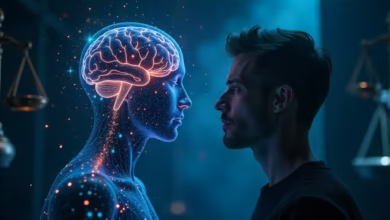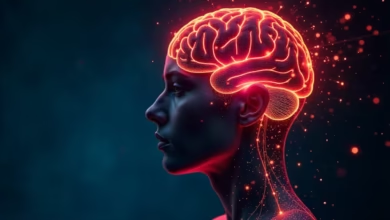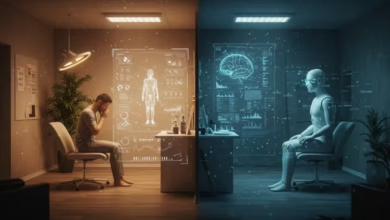AI vs Human Intelligence: Will Machines Ever Truly Think?

This blog post explores the intriguing debate of AI vs human intelligence, investigating if machines will ever truly think like humans. It begins by understanding the fundamental differences between AI and human intelligence, highlighting how these two forms of cognition operate on distinct principles. The article delves into the mechanics behind Artificial General Intelligence (AGI), explaining the pursuit of creating machines that can perform any intellectual task that a human can. A thorough comparison of the processes of the human brain and AI systems illustrates how human emotions, consciousness, and intuition contrast with algorithmic operations. Lastly, the article presents key insights and potential future directions in the development of AI, posing essential questions about the nature of intelligence itself. Through this exploration, the post aims to shed light on the capabilities and limitations of AI vs human intelligence.
Understanding The Differences Between AI And Human Intelligence
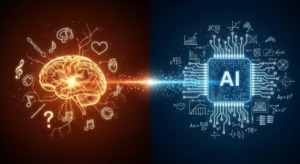
When discussing AI vs human intelligence, it is essential to recognize the fundamental distinctions in how each processes information. While human intelligence is characterized by emotional context, creativity, and depth of understanding, AI operates through algorithms and data-driven patterns. This divergence creates a unique landscape where both entities can excel in different areas. Humans leverage their emotional intelligence to make nuanced decisions, whereas AI excels in processing vast amounts of data efficiently, leading to quicker, more analytical outcomes.
Top Characteristics of AI and Human Intelligence
- AI utilizes algorithms to process data rapidly.
- Human intelligence involves emotional comprehension and empathy.
- Cognitive computing allows AI to learn from data inputs.
- Humans can draw on personal experiences to inform decisions.
- AI can operate without fatigue, performing tasks continuously.
- Human intuition plays a crucial role in problem-solving.
- AI relies heavily on data mining and pattern recognition.
As advancements in technology propel the conversation surrounding AI vs human intelligence, it becomes clear that while machines exhibit impressive capabilities, they are not replicas of human thinking. The essence of human thought encompasses subjective experiences and complex emotional responses that AI cannot replicate. Therefore, while AI can enhance decision-making processes and streamline operations, it lacks the profound depth that human intelligence brings into the equation. This understanding invites ongoing discussions about how both forms of intelligence can collaborate to forge a more advanced technological future.
The Mechanics Behind Artificial General Intelligence
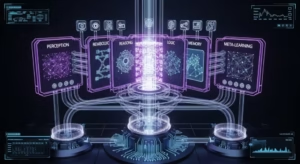
Artificial General Intelligence (AGI) refers to a type of AI that aims to replicate the cognitive abilities of the human brain, enabling machines to perform any intellectual task that a human can do. Understanding the mechanics behind AGI is crucial, as it distinguishes between narrow AI—systems designed for specific tasks—and the broader, more adaptable capabilities of AGI. While the pursuit of AGI promises revolutionary advancements, it also faces significant AI limitations that must be addressed to achieve true machine intelligence.
To construct an AGI, researchers must delve into various computational approaches that mimic human thought processes. This includes neural networks, natural language processing, and machine learning algorithms that evolve to improve performance over time. The eventual goal is to create a system that not only processes information but also understands context, reasoning, and even emotional intelligence, much like a human. As the field evolves, it raises fundamental questions about the essence of intelligence and the potential ethical implications of creating sentient machines.
| AGI Feature | Human Intelligence | AI Capability |
|---|---|---|
| Adaptability | High | Limited |
| Emotional Awareness | Inherent | None |
| Contextual Understanding | Strong | Variable |
| Learning Ability | Experience-Based | Data-Driven |
Despite the advancements in AI technology, the development of AGI is riddled with challenges. The complexity of human cognition, societal implications, and ensuring the ethical design of intelligent systems contribute to a landscape fraught with uncertainty. Overcoming these hurdles requires interdisciplinary collaboration among neuroscientists, computer scientists, and ethicists to innovate responsibly. Addressing these challenges is essential for shaping a future where machines can augment human capabilities rather than replace them.
Challenges in AGI Development
One of the primary challenges in developing AGI lies in effectively bridging the gap between algorithmic performance and human-like reasoning. Current systems often exhibit exceptional data processing capabilities but fail to emulate common sense reasoning or understand nuanced situations. Additionally, AI limitations manifest in the form of biases inherent in training datasets, which can lead to skewed decision-making processes that lack fairness and transparency. Tackling these challenges is pivotal, as the implications of AGI will extend far beyond technological advancements, influencing the ethical landscape of our society.
Current AGI Projects
As the quest for AGI unfolds, several groundbreaking projects are underway across the globe. Initiatives like OpenAI’s GPT models and Google’s DeepMind are at the forefront, experimenting with architectures designed to enhance machine understanding and mimic human-like interactions. These projects not only aim to improve existing AI capabilities but also strive to pioneer mechanisms that give rise to general intelligence. As these endeavors progress, the potential for high-impact advancements in various domains including healthcare, education, and automation grows exponentially.
Steps to Understanding AGI Development
- Familiarize yourself with the concepts of narrow AI versus AGI.
- Study the basic principles of neural networks and machine learning.
- Explore the intricacies of human cognitive processes and emotional intelligence.
- Investigate current AGI projects and their methodologies.
- Analyze the ethical considerations surrounding the development of AGI.
- Stay updated on breakthroughs and challenges in the AI field.
- Engage in discussions about the potential societal impacts of AGI.
Comparing The Processes Of The Human Brain And AI Systems
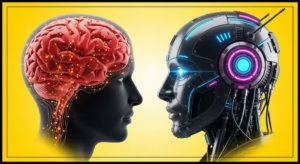
The comparison between the human brain and AI systems underscores fundamental differences in how intelligence is processed and utilized. While the human brain operates through complex biological constructs, AI systems rely on algorithms and computational power. One key aspect is that the human brain excels in emotional intelligence and social interactions, features that are inherently challenging for AI to replicate. Conversely, AI systems efficiently process vast amounts of data at speeds unattainable by the human brain, showcasing a significant advantage in cognitive computing for specific tasks.
| Aspect | Human Brain | AI Systems |
|---|---|---|
| Processing Style | Bilateral, associative | Linear, algorithmic |
| Learning Method | Experiential, intuitive | Data-driven, statistical |
| Emotional Understanding | High | Limited |
| Speed | Slow, relative to tasks | Fast, consistent |
Moreover, both systems exhibit unique attributes when it comes to processing information. While the human brain can rely on context and experience to make decisions, AI systems require structured data and predefined parameters. This distinction makes it essential to explore how these systems perform under various circumstances. For instance, humans can adapt to new situations without prior experience, while AI systems often struggle unless adequately trained through machine learning.
Key Similarities and Differences
- Both can learn and adapt over time.
- The human brain utilizes emotional intelligence, while AI lacks this ability.
- Humans rely on intuition; AI depends on data.
- AI can process information more quickly than humans.
- The human brain is versatile; AI is task-specific.
- Humans create knowledge; AI analyzes existing data.
In summary, the processes of thought and decision-making differ considerably between the human brain and AI systems. While AI achieves remarkable feats in computational tasks, the essence of human cognition includes emotional and context-driven understanding, representing a frontier that AI has yet to fully explore. As cognitive computing evolves, understanding these differences will be vital in shaping the future interactions between AI vs human intelligence. The questions about whether machines will ever truly think remain open for debate as technology progresses.
Key Insights And Future Directions In AI Development

The ongoing exploration of AI vs human intelligence has revealed critical insights into both fields. While AI has shown remarkable capabilities in specific domains, it still faces significant AI limitations that distinguish it fundamentally from human thought processes. For instance, AI relies heavily on data patterns and algorithms, but it lacks the emotional depth and understanding that characterize human intelligence. As enterprises integrate AI technologies, understanding these limitations becomes essential for optimizing their applications and avoiding over-reliance on machine decisions.
5 Actionable Takeaways for Understanding AI
- Recognize that AI is a tool and not a replacement for human judgement.
- Understand the importance of data quality in AI performance.
- Stay informed about the ethical implications of AI and its impact on society.
- Acknowledge the areas where AI excels, such as data processing and automation.
- Consider the limitations of AI, including its inability to reason like a human or understand context fully.
- Encourage collaboration between AI systems and human intelligence to maximize outcomes.
- Keep an eye on emerging technologies that could bridge the gap between AI and human reasoning.
As we move forward, it’s crucial to engage in ongoing discussions about the future directions of AI development. This involves not only enhancing the capabilities of AI technologies but also addressing the ethical dimensions and the AI limitations that impact their adoption in various industries. Understanding the interplay between AI vs human intelligence will shape technological advancements and foster a future where both can thrive synergistically, each complementing the other’s capabilities without erasing the unique qualities that define human cognition.
Briefing Document: AI vs. Human Intelligence – Core Themes and Insights
I. Fundamental Distinctions Between AI and Human Intelligence
The core premise of the source is that while both AI and human intelligence process information, they do so based on fundamentally distinct principles, leading to different strengths and limitations.
- Processing Mechanisms:Human Intelligence: Characterized by “emotional context, creativity, and depth of understanding.” It leverages “emotional intelligence to make nuanced decisions” and can “draw on personal experiences to inform decisions.”
- AI: Operates “through algorithms and data-driven patterns.” It excels in “processing vast amounts of data efficiently, leading to quicker, more analytical outcomes.” AI utilizes “algorithms to process data rapidly” and relies heavily on “data mining and pattern recognition.”
- Key Differentiating Characteristics:Emotional Comprehension/Empathy: Human intelligence possesses this inherently, while AI systems lack it (“AI lacks the profound depth that human intelligence brings into the equation”).
- Intuition/Context: Humans utilize intuition in problem-solving and can “rely on context and experience to make decisions,” adapting to new situations without prior experience. AI “depends on data” and “requires structured data and predefined parameters,” often struggling with adaptation unless specifically trained.
- Fatigue: “AI can operate without fatigue, performing tasks continuously,” a clear advantage over human capabilities.
- Knowledge Creation vs. Analysis: “Humans create knowledge; AI analyzes existing data.”
II. The Mechanics and Challenges of Artificial General Intelligence (AGI)
The source delves into Artificial General Intelligence (AGI), defining it and outlining the significant hurdles in its development.
- Definition of AGI: AGI aims to “replicate the cognitive abilities of the human brain, enabling machines to perform any intellectual task that a human can do.” This distinguishes it from “narrow AI—systems designed for specific tasks.”
- Computational Approaches for AGI: Researchers are exploring “neural networks, natural language processing, and machine learning algorithms that evolve to improve performance over time” to mimic human thought processes.
- The Ultimate Goal of AGI: To create a system that “not only processes information but also understands context, reasoning, and even emotional intelligence, much like a human.”
- Challenges in AGI Development (AI Limitations):Bridging Algorithmic Performance and Human-like Reasoning: Current systems “often exhibit exceptional data processing capabilities but fail to emulate common sense reasoning or understand nuanced situations.”
- Bias in Training Datasets: “AI limitations manifest in the form of biases inherent in training datasets, which can lead to skewed decision-making processes that lack fairness and transparency.”
- Complexity of Human Cognition: Replicating human cognition, societal implications, and ensuring ethical design contribute to a “landscape fraught with uncertainty.”
- Current AGI Projects: Initiatives like “OpenAI’s GPT models and Google’s DeepMind” are at the forefront, aiming to enhance machine understanding and mimic human-like interactions, with potential “high-impact advancements in various domains including healthcare, education, and automation.”
III. Comparing the Processes of the Human Brain and AI Systems
The source further elaborates on the operational differences and similarities between the human brain and AI systems.
- Processing Style:Human Brain: “Bilateral, associative.”
- AI Systems: “Linear, algorithmic.”
- Learning Method:Human Brain: “Experiential, intuitive.”
- AI Systems: “Data-driven, statistical.”
- Speed: AI systems show a “significant advantage in cognitive computing for specific tasks” due to their ability to “efficiently process vast amounts of data at speeds unattainable by the human brain.” The human brain is described as “Slow, relative to tasks,” while AI is “Fast, consistent.”
- Versatility: “The human brain is versatile; AI is task-specific.”
- Similarities: Despite their differences, “Both can learn and adapt over time.”
IV. Key Insights and Future Directions in AI Development
The document emphasizes critical insights and future considerations for AI’s evolution, particularly regarding its limitations and the importance of human-AI collaboration.
- AI as a Tool, Not a Replacement: A crucial takeaway is to “Recognize that AI is a tool and not a replacement for human judgement.”
- Importance of Data Quality: “Understand the importance of data quality in AI performance.”
- Ethical Considerations: Staying “informed about the ethical implications of AI and its impact on society” is vital.
- Acknowledging AI’s Strengths and Limitations: It’s important to “Acknowledge the areas where AI excels, such as data processing and automation” while also considering “the limitations of AI, including its inability to reason like a human or understand context fully.”
- Fostering Collaboration: The future direction of AI involves encouraging “collaboration between AI systems and human intelligence to maximize outcomes.” The goal is to “foster a future where both can thrive synergistically, each complementing the other’s capabilities without erasing the unique qualities that define human cognition.”
- Ongoing Debate: The fundamental question of “whether machines will ever truly think remains open for debate as technology progresses.”
In conclusion, the source underscores that while AI boasts impressive capabilities in data processing and automation, it fundamentally differs from human intelligence in its lack of emotional depth, intuition, and nuanced contextual understanding. The pursuit of AGI aims to bridge these gaps, but significant ethical and technological challenges remain. The future of intelligence is envisioned as a collaborative synergy between AI and humans, leveraging each other’s unique strengths.
For similar articles, please visit: AI and Human Mind & Psychology
Homepage / humanaifuture.com
🎧 Listen to the Podcast
Want to explore this topic in more depth? Listen to the full podcast for more insights and expert commentary.
▶️ Play on Google DriveNo sign-up needed — just click and listen.
What is Artificial General Intelligence (AGI), and how does it differ from narrow AI?
Artificial General Intelligence (AGI) aims to replicate the full cognitive abilities of the human brain, enabling machines to perform any intellectual task a human can. This means an AGI system would not only process information but also understand context, reason, and potentially exhibit emotional intelligence. Narrow AI, on the other hand, refers to systems designed for specific, limited tasks, such as facial recognition or language translation. The pursuit of AGI involves computational approaches like neural networks, natural language processing, and machine learning algorithms that can evolve and improve over time, striving for broader, more adaptable capabilities than narrow AI.
What are the primary challenges in developing AGI?
Developing AGI faces significant hurdles. One major challenge is bridging the gap between current algorithmic performance and human-like reasoning, as present systems often lack common sense understanding and the ability to handle nuanced situations. Another key limitation is the presence of biases inherent in training datasets, which can lead to skewed, unfair, or non-transparent decision-making processes in AI. The complexity of human cognition, societal implications, and ensuring the ethical design of intelligent systems also contribute to the challenges, requiring interdisciplinary collaboration among neuroscientists, computer scientists, and ethicists.
How do the learning methods of human brains and AI systems compare?
The human brain learns primarily through experience, intuition, and associative processing. It can adapt to new situations without prior experience and create new knowledge. AI systems, conversely, learn through data-driven, statistical methods, relying on structured data and predefined parameters. While AI can learn and adapt over time through cognitive computing and machine learning, its understanding is largely based on analyzing existing data and recognizing patterns, rather than developing new insights independently through lived experience.
What key attributes does the human brain possess that AI systems currently lack?
The human brain possesses emotional intelligence, empathy, intuition, and the ability to understand and utilize subjective experiences. It excels in social interactions and can rely on context and prior experience to make nuanced decisions, even in novel situations. AI systems, while advanced in data processing, currently lack genuine emotional understanding, common sense reasoning, and the profound depth of human cognition that allows for truly intuitive or emotionally informed decision-making.
What are the advantages of AI systems over the human brain in certain tasks?
AI systems have a significant advantage in cognitive computing for specific tasks, primarily due to their ability to process vast amounts of data rapidly and consistently. They can perform analytical outcomes quicker than humans, operate without fatigue, and are highly efficient in tasks requiring data mining and pattern recognition. This makes AI exceptionally useful for streamlining operations and enhancing decision-making processes in data-intensive fields.
Why is recognizing AI's limitations important for its effective integration?
Recognizing AI's limitations is crucial because it helps optimize AI applications and prevents over-reliance on machine decisions. AI fundamentally lacks emotional depth, human-like reasoning, and full contextual understanding. Understanding these limitations ensures that AI is used as a powerful tool to augment human judgment and capabilities, rather than attempting to replace human intelligence entirely, which could lead to flawed or ethically problematic outcomes where nuanced human understanding is required.
What is the future direction of AI development, and how will it interact with human intelligence?
The future direction of AI development involves not only enhancing AI capabilities but also critically addressing its ethical dimensions and limitations. The goal is to foster a synergistic relationship where AI and human intelligence can thrive together, each complementing the other's strengths. This means encouraging collaboration between AI systems and humans to maximize outcomes, staying informed about ethical implications, and exploring emerging technologies that could bridge the gap between AI and human reasoning without erasing the unique qualities that define human cognition. The debate about whether machines will ever truly think like humans remains open as technology progresses.

